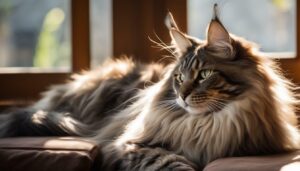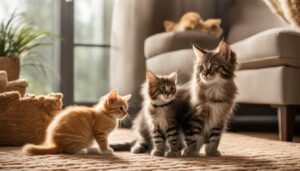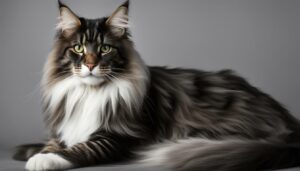Welcome to the world of polydactyl Maine Coons! These fascinating felines are known for their extra toes and distinct charm. Polydactyl Maine Coons are Maine Coon cats with extra toes, a unique genetic trait that sets them apart. The polydactyl gene is harmless and not linked to any other anomalies, making it a preferred trait for health and vigor. To have a polydactyl kitten, one parent must be polydactyl. While not all Maine Coons are polydactyl, this breed has a higher occurrence of polydactylism compared to others.
Key Takeaways:
- Polydactyl Maine Coons have extra toes, a unique genetic trait.
- The polydactyl gene is harmless and not linked to any other anomalies.
- At least one parent must be polydactyl for the kittens to inherit the trait.
- Polydactyl Maine Coons are considered a preferred trait for health and vigor.
- The breed has a higher occurrence of polydactylism compared to other breeds.
The Polydactyl Gene and Characteristics
The polydactyl gene is a harmless genetic trait found in Maine Coon cats that leads to the development of extra toes on their paws. These adorable felines can have up to two additional toes on each paw, making them truly unique. While not all Maine Coons are polydactyl, this special trait is more common in this breed compared to others.
Aside from their charming extra toes, polydactyl Maine Coons possess the same physical and behavioral characteristics as their non-polydactyl counterparts. They are known for their large size, muscular build, and tufted ears. Maine Coons, whether polydactyl or not, are gentle, sociable, and highly intelligent cats. Their friendly nature and playful attitude make them wonderful companions for both individuals and families.
“The polydactyl Maine Coon is a delightful combination of elegance and uniqueness.”
One interesting fact about the polydactyl gene is that it does not cause any health issues or abnormalities in Maine Coons. In fact, it is considered a desirable trait for these cats as it adds to their overall health and vigor. Polydactyl Maine Coons can be registered with any official cat association, and their extra toes do not affect their eligibility for shows or competitions. These cats are a living testament to the breed’s long heritage, with the polydactyl gene being introduced through ship cats that sailed to Maine from Boston and mingled with polydactyl cats there.
To ensure the well-being of polydactyl Maine Coons, it is important to pay attention to their paw health. Regularly check their toes for any signs of discomfort or infection. Additionally, trimming their nails and providing scratching posts and toys can help keep their paws in optimal condition. By maintaining a stimulating environment and meeting their specific needs, you can ensure that your polydactyl Maine Coon leads a happy and healthy life.
| Key Points | Summary |
|---|---|
| Polydactyl Maine Coons have extra toes | Unique and charming trait |
| No health issues associated with polydactyl gene | Considered a desirable trait for health and vigor |
| Maine Coons are sociable and gentle cats | Perfect companions for individuals and families |
| Paw health is important for polydactyl Maine Coons | Regular checks, nail trimming, and providing scratching options |
The History and Cultural Significance
Polydactyl Maine Coons have a rich history intertwined with the development of the Maine Coon breed itself, and their unique traits continue to captivate cat lovers today. This fascinating breed originated in the state of Maine, where it gained popularity for its ability to survive harsh winters and hunt vermin on ships and farms. It is believed that the polydactyl gene was introduced to the Maine Coon breed through ship cats that sailed to Maine from Boston and mingled with polydactyl cats there.
The presence of extra toes on their paws earned these cats the nickname “Hemingway Cats” after the famous writer Ernest Hemingway, who was known for his fondness of polydactyls. Today, many polydactyl Maine Coons can still be found at the Ernest Hemingway Home and Museum in Key West, Florida, where a colony of these unique cats roams freely. They have even become a symbol of good luck in some cultures.
Polydactyl Maine Coons hold a special place in the hearts of cat enthusiasts, and many breeders take pride in preserving their lineage. However, over time, the occurrence of polydactylism in Maine Coons has decreased as breeders have started to selectively breed out the trait in favor of conforming to breed standards. Despite this, the historical and cultural significance of polydactyl Maine Coons remains, and they are cherished for their connection to the breed’s long and storied heritage.
| Breeders | For Sale | Rescue |
|---|---|---|
| ABC Maine Coons | XYZ Maine Coon Kittens | Maine Coon Rescue Center |
| Maine Coon Legends | Maine Coon Breeder USA | Coonhounds and Coons Rescue |
Caring for Polydactyl Maine Coons
As with any cat, polydactyl Maine Coons require specific care to ensure their well-being, from regular grooming to providing appropriate toys and scratching posts. Grooming is especially important for these cats due to their extra digits. Regular brushing helps keep their fur clean and free from mats. Additionally, their extra toes may require special attention. It is essential to regularly check their paw health, trim their nails, and monitor for any signs of discomfort or infection.
To keep your polydactyl Maine Coon happy and entertained, provide a variety of toys that engage their curiosity and satisfy their natural instincts. Interactive toys, such as puzzle feeders or wand toys, can stimulate their minds and provide mental stimulation. It’s also crucial to have scratching posts and cat trees available to satisfy their need to scratch and climb. These cats are typically active and agile, so providing them with opportunities for exercise is essential for their overall well-being.
In addition to physical care, it is equally important to create a safe and comfortable environment for your polydactyl Maine Coon. Make sure they have a cozy bed or designated sleeping area where they feel secure. Provide them with hiding spots, such as cat tunnels or boxes, where they can retreat when they need some alone time. Creating vertical spaces, such as shelves or perches, allows them to observe their surroundings and fulfill their natural desire to climb and explore.
| Key Care Points for Polydactyl Maine Coons |
|---|
| Regular grooming and paw health checks |
| Trimming nails as needed |
| Providing a variety of engaging toys |
| Offering scratching posts and cat trees |
| Creating a safe and comfortable environment |
Remember that each polydactyl Maine Coon is an individual with unique needs and preferences. Spend time interacting with your cat, observing their behavior, and adjusting your care routine accordingly. By providing the right care and environment, you can ensure that your polydactyl Maine Coon thrives and enjoys a happy and fulfilling life.
Conclusion
Polydactyl Maine Coons are truly extraordinary creatures, showcasing the rich heritage and diversity of the Maine Coon cat breed. With their charming extra toes, they stand out as unique and captivating feline companions. The polydactyl gene, a harmless genetic trait, adds an interesting twist to their physical appearance and behavior.
Despite being a preferred trait for health and vigor, the occurrence of polydactyl Maine Coons has decreased over time as breeders have selectively bred to reduce the polydactylism. However, these enchanting cats still hold historical and cultural significance within the Maine Coon community.
The introduction of the polydactyl gene to the Maine Coon breed can be traced back to ship cats that sailed to Maine from Boston and interbred with polydactyl cats in the region. This unique heritage makes polydactyl Maine Coons a visible proof of the breed’s long and fascinating history.
When welcoming a polydactyl Maine Coon into your home, it’s essential to prioritize their paw health. Regularly checking their paws, trimming their nails, and providing appropriate scratching posts and toys are crucial for their well-being. While not all Maine Coons are polydactyl, those with extra toes offer a delightful reminder of the breed’s diversity and individuality.
FAQ
Q: Are all Maine Coons polydactyl?
A: No, not all Maine Coons are polydactyl. While they have a higher occurrence of polydactylism compared to other breeds, it is not a universal trait.
Q: What are polydactyl Maine Coons?
A: Polydactyl Maine Coons are Maine Coon cats with extra toes. They can have up to two extra toes on each paw.
Q: Is the polydactyl gene linked to any other anomalies?
A: No, the polydactyl gene is a harmless genetic trait and is not linked to any other anomalies.
Q: How can I have a polydactyl kitten?
A: To have a polydactyl kitten, one parent must be polydactyl. The polydactyl gene is passed down from generation to generation.
Q: Can polydactyl Maine Coons be registered with official cat associations?
A: Yes, polydactyl Maine Coons can be registered with any official cat association.
Q: Are there any ill effects of the polydactyl gene in Maine Coons?
A: No, there are no ill effects of the polydactyl gene in Maine Coons. In fact, it is considered a preferred trait for health and vigor.
Q: How should I care for my polydactyl Maine Coon’s paws?
A: It is important to regularly check their paw health, trim their nails, and provide scratching posts and toys to keep their paws in good condition.
Q: Has the occurrence of polydactyl Maine Coons decreased?
A: Yes, the occurrence of polydactyl Maine Coons has decreased as breeders have started to breed out the trait. However, they still hold historical and cultural significance.
Q: How did the polydactyl gene come to the Maine Coon breed?
A: The polydactyl gene was introduced to the Maine Coon breed through ship cats that sailed to Maine from Boston and mingled with polydactyl cats there.
Q: What is the significance of polydactyl Maine Coons?
A: Polydactyl Maine Coons are seen as a distinct and visible proof of the breed’s long heritage, adding to their historical and cultural importance.



